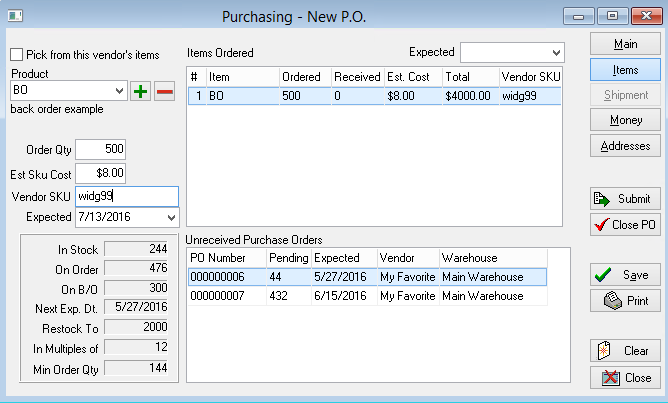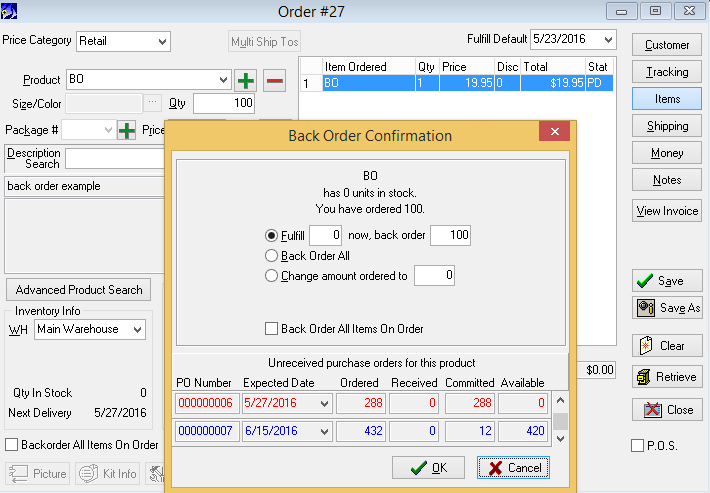Purchasing (PO) Module
From NewHaven Software Wiki
Russ horton (Talk | contribs) (→Creating PO's) |
Russ horton (Talk | contribs) (→Managing and Visibility) |
||
| (One intermediate revision not shown) | |||
| Line 78: | Line 78: | ||
Current PO information is also available to your operators in Order Entry so they can see when a backordered item is expected to become available. This can even be used in eCommerce integrations (e.g. CommerceV3) to indicate the expected availability date for a back ordered item. CMS will look at the total units available, how many are on back order, and when PO's are expected to be received to produce this availability date. If, for example, you're expecting three shipments at different dates and there are units back ordered in excess of what the first two PO receipts would bring in, CMS will upload the expected date of the third PO. | Current PO information is also available to your operators in Order Entry so they can see when a backordered item is expected to become available. This can even be used in eCommerce integrations (e.g. CommerceV3) to indicate the expected availability date for a back ordered item. CMS will look at the total units available, how many are on back order, and when PO's are expected to be received to produce this availability date. If, for example, you're expecting three shipments at different dates and there are units back ordered in excess of what the first two PO receipts would bring in, CMS will upload the expected date of the third PO. | ||
| + | |||
| + | [[image:POsOpenforBO.png]] | ||
Current revision as of 16:41, 11 September 2018
Contents |
Overview
Do you resell products purchased from other vendors or drop shippers? The Purchasing Module was designed to streamline the process of placing orders with your vendors to have them ship stock to you or right to your customers.
Using the Purchasing Module will enhance your inventory management by keeping track of how many units you have on order and when they are expected to arrive which is critical information to have both when placing new purchase orders. This information is also used in Order Entry so your operators can see when a backordered item is expected to become available and on your website where you can show an anticipated availability date or even control if shoppers should see the item. Receiving PO’s is a snap and allows you to track accurate product costs, complete with any landed costs.
For drop shippers, CMS will automatically create a PO for your vendor when an order is placed for a drop shipped item. When you receive notification from the vendor that the item has shipped, you can close the PO which will update the shipped date on the order, add a tracking number, and can trigger an emailed shipment confirmation to your customer that includes the tracking number.
Purchasing Challenges
If you place purchase orders with your vendors, you know how cumbersome the process can be:
- Creating PO's in Word, Excel, or your accounting system
- Troubles deciding how much to order
- Knowing when to expect your shipments to arrive (stock planning with overlapping PO's)
- Manually receiving stock into CMS for each line item
- Landed Costs - distributing the fees (e.g. shipping) associated with the PO across the received items
- Updating your product/lot costs based on the vendor's invoice
CMS's Purchasing Module was designed to streamline the entire process of placing orders with your vendors, either to have them ship stock to you or right to your customers (drop shipping). Read on to learn how CMS's Purchase Module can help you be more effective in interacting with your vendors and your stock management.
(This module is included with CMS Professional and is an option available to purchase for use with CMS Standard.)
CMS Purchasing Module
Creating PO's
Create professional looking purchase order forms either that will print to your pre-printed stock or to plain paper. You can use stock templates we provide or have a form customized to meet your specific design requirements including the addition of your company graphics.
Some of the many ways in which the Purchasing Module improves the efficiency of creating PO’s:
- Easy to create, flow of entry is very similar to Order Entry
- CMS will remember the terms, shipping method, and lead time you've used with that vendor previously and default to using those again
- When creating PO’s you can limit the items selectable to only those you’ve told CMS that you order from that vendor
- Pending PO's - The initial state of a newly created PO is "pending" meaning you can take all the time you need to work on the PO, save, come back and edit as many times as needed before submitting to the vendor
- Multiple vendors - tell CMS which vendors you order each product from as well as their unique lead times, terms, default shipping method, and minimum order quantities
- For each vendor you can store the vendor’s product code (if different than yours), your cost, quantity discounts, different unit quantities (case, pallet, etc.), and lead time (by vendor and/or product)
- Multi-warehouse support - separate PO's, receiving, stock levels, reorder points, etc. for each of your warehouses
- When entering PO's CMS display on the fly sales/purchasing data for the selected line item, including open PO’s, helping with last second decisions on how much to order. Data includes **Quantity in stock
- How many on order
- How many on back order
- Next expected delivery date
- Restock To qty
- In Multiples of (a reminder that this item can only be ordered in multiples of X)
- Min Order Qty
- PLUS CMS will also display a list of all of the open PO's that contain the selected item with the unreceived qty and expected dates.
Drop Ships
Increasingly we’re seeing companies incorporate a higher percentage of drop shipped products in their mix as a means of expanding their product offerings without expanding warehouse capacity. The trade-off is having to create an abundance of PO’s to your vendors to notify them of which products to ship to which customers/addresses. CMS’s Purchasing Module to the rescue!
- CMS can automatically create a PO for each drop shipped item on each order. If multiple items are purchased from the same vendor on the same order, they will be added to the same PO. The PO will reference your order number as well as the shipping method and address from that order.
- When the vendor notifies you of shipment, you can “confirm” the PO in CMS setting the shipped date and tracking number(s). This closes the PO (when fully sent) and update the CMS invoice to post those tracking numbers and shipped dates which in turn allows CMS to send shipping confirmation emails with those tracking numbers.
Receiving
Receiving purchase orders, normally a tedious process, can now be done in a snap! Gone are the days of manually receiving stock for each individual item. You just tell CMS how many of each item you've received today, using an efficient Order Entry type interface, and in one click all of the items are received and corresponding lots are created.
- Options to default cost and quantity received to speed up receiving
- Option to set a threshold percentage to warn you when the actual cost deviates from the expected cost by more than X% (this can be done during receiving or later when the invoice arrives)
- Order in vendor/case quantities and receive in individual units - In other words, you can order 1 x Case of Widgets from your vendor and, when received, CMS will know this represents 100 saleable units and receive them as such with appropriate unit cost.
- Vendor Lot ID - Track the lot numbers provided by your vendor to facilitate FDA recall reporting, for example
- Expiration date - Option to specify the expiration date for the received inventory lot for perishable items
- A single PO can have multiple receipts/shipments, each with its own charges
- For each receipt CMS will provide a wizard to help you distribute associated fees like the shipping charge to arrive at a padded or "landed" cost for each lot
- When an item is received and if its cost is edited later (when the invoice arrives) CMS will:
- update the cost on file for each item to be used for future purchases
- update the lot's cost
- update the cost of goods (COG) for any items already sold from that item's lot
- find any kits that were built (see Kit Builder) using this item as a component and update the assembled kit's COG
Managing and Visibility
Using the Purchasing Module can improve your inventory management such as keeping track of how many units you have on order and when they are expected to arrive, information that can be critical both for placing new purchase orders and stock planning.
- Track PO’s status (pending, submitted, received, closed)
- Easy to find/view PO’s with search ability by vendor, product code, vendor code, status, PO#, or order# (drop ships)
- Reporting
- Receiving report - checklist of items for receiving a PO
- Summary of all PO activity
- Summary of activity by vendor
- Product purchasing summary
- Delivery Status
- Order Entry display of open PO’s and quantity available
- Availability dates available to eCommerce integrations
Current PO information is also available to your operators in Order Entry so they can see when a backordered item is expected to become available. This can even be used in eCommerce integrations (e.g. CommerceV3) to indicate the expected availability date for a back ordered item. CMS will look at the total units available, how many are on back order, and when PO's are expected to be received to produce this availability date. If, for example, you're expecting three shipments at different dates and there are units back ordered in excess of what the first two PO receipts would bring in, CMS will upload the expected date of the third PO.


